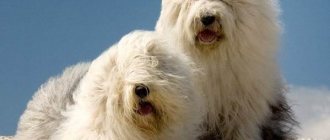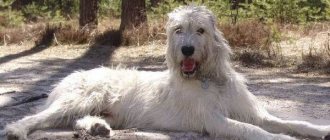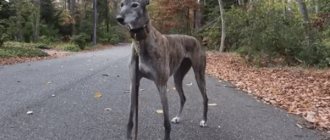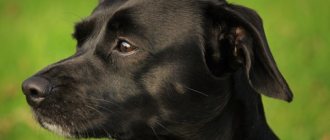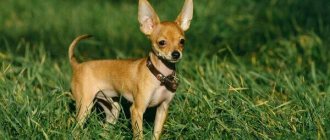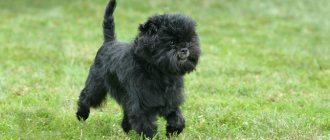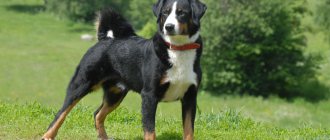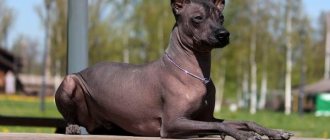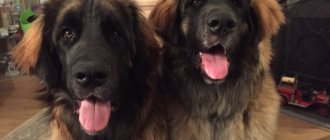The Bobtail is a large, hardy dog, in the past it was a herding dog, and today it is an excellent companion, good-natured and active friend. The first thing that catches your eye when meeting a dog of this breed is its unusual, almost completely absent tail and stunning, thick and fluffy fur .
What the animal looks like, what to feed it and how to care for it, who it is suitable for and how much such a puppy costs - the article will tell you about all this.
Description of the breed
The bobtail breed was bred in England in the 18th century - at least, the first mention of these animals dates back to this time. A dog very similar to a bobtail appears in a painting by the artist Gainsborough, who worked in the 18th century. Initially, when breeding the breed, the following goals were pursued: the animal had to simultaneously pose a threat to predators and not frighten sheep . Hence the large size and camouflage thick white fur.
Interesting: by the way, these pets used to be shorn just like sheep. From one bobtail you can get about 1.5 kg of wool per year, but it is very warm and soft. While brushing your pet, it is quite possible to knit mittens or socks!
Name options and varieties
The Bobtail, or, as it is also called, the Old English Sheepdog (bob-tailed sheep-dog, old English sheepdog), got its name for a reason. In England, there used to be a law according to which the amount of a shepherd's tax on his dog depended on the length of the dog's tail. Enterprising shepherds began trimming the tails of their pets. This is how the bobtail appeared, from English - “short tail”. Dogs of this breed are born with a normal tail, but it is docked in the first days of birth. In some countries today the tail is not cut - in this case the animal can boast of a fluffy gray tail, also with a white tassel at the end. However, a dog without a tail looks more original, and a tailed pet will not be allowed to participate in exhibitions.
Does it smell like dog?
Yes, the Bottail is not one of those breeds that is completely odorless .
But it is worth remembering that a healthy, well-groomed dog will practically not smell like a dog. The smell intensifies during bathing, and the bobtail will have to be bathed frequently. So, if the issue with smell is fundamental, it is better to wash it with a special shampoo.
But the bobtail practically does not shed, which is essential for such a cloud of fur. Its coat consists of guard hair and undercoat.
The guard hair will change to a lighter color up to three years of age and will not shed after that. And in the spring, the undercoat will have to be combed out so that the dog does not get tangled, but it will not remain on carpets and clothes.
Other Features
You can distinguish a bobtail dog by its bark, which is very characteristic, loud and hoarse. By the way, if a puppy gets bored, he will bark a lot and with pleasure, so it’s better to start him with enough time to play and exercise with him. At the same time, he will be able to get along in a small apartment with the condition of daily walking.
Interesting: by the way, these pets used to be shorn just like sheep. From one bobtail you can get about 1.5 kg of wool per year, but it is very warm and soft. While brushing your pet, it is quite possible to knit mittens or socks!
Pets of this breed are popular in Hollywood films and cartoons. Outwardly, this animal looks like a good-natured bear, but if desired, it can move easily and quickly.
Meet the parents
If you know exactly what the puppy's mom and dad look like, it will be easier to guess its approximate size: small, medium or giant. At the same time, you need to understand that if the dogs were of different heights, the puppies will take after either their mother or their father. Therefore, a litter may contain both large and medium-sized dogs at once.
Often only the mother stays with newborns, so her size is taken into account. Female puppies will grow approximately as big as their mother, while male puppies will grow 15% larger. Also look at the puppies' initial height and weight. Small ones will develop gradually and grow to medium size, while large ones that stand out among their siblings will likely grow to be taller than average.
Character
The Bobtail has a calm, balanced disposition without any surprises, which is valuable considering its size. Dogs are obedient and not pugnacious, they love activity. They look after children, it is in their genes: the bobtail “grasses” the baby, as it once herded sheep. This is why they got the nickname nanny dogs.
Highly intelligent, easy to train, easy to learn new commands and love it. Of course, they are loyal to the owner.
But you need to teach your dog calmly and consistently, encouraging it and without using physical force. Otherwise, the bobtail will be stubborn.
What to do if you have a mixed breed puppy
If you have a mixed breed puppy, you may feel like you are completely in the dark about knowing, or even just guessing, what weight your dog should be.
You can do this in two ways. You can take a look at all the weight charts on this page and see which chart is best for your puppy. Or if you wanted to be more precise, use a DNA test to see what breeds your puppy mixes with. Then you will know which puppy weight chart to use.
Wisdom Panel is a simple cheek swab test that will determine which breeds your puppy is crossed with, and there are over 250 breeds, types and varieties of dogs.
It can identify purebred ancestors going back three generations, giving you a good idea of what your puppy's weight will be.
© shutterstock
Standard and characteristics
The Bobtail is a large and muscular dog, square in format and not very tall, but muscular. Her entire body is covered with thick, coarse, slightly wavy, but without curls, fur.
Weight
Female: 27–36 kg , male: 32–45 kg . The average weight that an animal is likely to reach is 30–35 kg .
Dimensions
Large size and symmetrical build. The dog is not small in itself, but because of the abundant fur it seems downright huge.
Height
The height at the withers of males is not lower than 56 cm, females - 54 cm. The desired height for males is 61 cm, females - 56 cm. Bobtail dogs are well built, the back of their body is somewhat raised in relation to the withers .
Color
The color is beautiful, mostly gray, with different shades:
- gray-blue;
- marble blue;
- blue with black;
- white.
The size of the white spots is not important; they may also be completely absent. But the brown and brown tone is recognized as a defect of the breed.
Distinctive features
A strong, muscular dog of a square format, with a thick coat and undercoat. Quite light for its size: 32-46 kg with a height of 54-63 cm. The standard does not separate females and males. Insufficiently strong muscles are a disadvantage.
The standard was defined in 1888 and has remained virtually unchanged since then. In 2004, the latest amendment was made, according to which all individuals that do not meet the criteria for appearance and behavior are discarded and are not allowed for further breeding.
- The head is proportional to the body. The skull is large, square, with a well-defined stop. The brow ridges are bright, the cheekbones are prominent.
- The muzzle is square, chopped, of medium length (half the length of the head), straight. The jaws are strong, with even teeth. The bite is scissor-shaped (the upper jaw overlaps the lower jaw), the teeth are vertical. The lips are thin, not jagged, and the color is black.
- The nose is large, the nostrils are large and open. The pigment is only black.
- The eyes are small, oval, widely set. The color of the iris is dark brown, perhaps light in some colors. The outline is black, pronounced.
- The ears are set slightly above the eye line and hang down to the sides. The shape is triangular, the wool is medium length.
- The body is muscular with strong bones. Format – square. The loin is wide and quite convex. The chest is deep, flat on the sides. The withers are pronounced. The topline is short and straight. The stomach is tucked, but not lean. The neck is set high and long.
- The tail should be short at birth (3-5cm), otherwise it should be docked.
- The limbs are straight, parallel, and not long. The hind thighs are rounded, slightly arched. Low hock joints. The paws are round, small, “cat-like”, the toes are collected. The claws are black and strong. Movements are free when running, shuffling when walking.
- The coat is shaggy (may appear unkempt), long, tangled, wavy, harsh, oily (due to excretions). The longest on the hips, the shortest on the ears. The undercoat lies tightly to the body and is waterproof.
- The color is blue, grayish, ash, blue merle (in combination with large white spots). The legs are usually wearing boots, and the muzzle is light-colored.
Comparison with other similar breeds
The Bobtail is a type of herding dog. The Bernese Mountain Dog, Hungarian, Portuguese and South Russian Shepherd Dogs and the Briard are a little similar to it. The last two breeds are also related to the bobtail - it was presumably developed as a result of their crossing. It is distinguished by , firstly, a very beautiful white coat, which other breeds do not have (even the South Russian Shepherd has a distinctly yellow coat), and secondly, a balanced, more affectionate character than the rest .
Pros and cons of the breed
The Old English Sheepdog is completely unsuitable for homebodies, inactive and weak-willed people. This type of dog requires an experienced leader who enjoys outdoor activities and knows how to handle guard dogs. If the bobtail is of interest to you, check out its pros and cons.
Advantages:
1. Beautiful appearance. 2. Love for children. 3. Excellent guard qualities. 4. Performance and endurance. 5. Loyalty and good nature.
Content Features
The dog is perfect for keeping as a pet, as well as in a private home. “Sofa existence” will be quite comfortable for the animal, as will leisurely walks through private territory. Small bobtails are very active, but then they will only be happy with infrequent and not very noisy games.
The bobtail does not tolerate loneliness well, but it loves the company of people. So it’s worth getting one for a large family, where someone is always at home. Otherwise, at one moment, returning to the apartment, you can find it destroyed - this bobtail, in the absence of its beloved owner, tried to entertain itself as best it could . At the same time, the dog should have its own separate place in the house, large enough and comfortable.
A bobtail will be comfortable in any climate - its thick coat protects it not only from cold and snow, but also from rain and heat.
Reproduction and lifespan
Bobtails reach childbearing age around the age of one year. But the offspring of young parents can be weak, so they plan to breed dogs no earlier than they are one and a half years old. The ideal age is 3-4 years.
Future parents meet on the dog's territory. If the mating is successful, the gestation period is from 58 to 62 days. The pregnancy of a bobtail bitch becomes obvious after a month.
Bobtails give birth to many puppies: from 5 to 8. They stay with their mother for about two months.
Bobtails live 10-11 years.
Care
Bobtail is one of those animals whose care requires certain skills and dexterity. Here is a short list of what exactly needs to be done if a dog of this breed lives in the house:
- The most important thing is to care for the coat , it is long and needs constant attention. It should be brushed at least three times a week. Otherwise, the wool will become matted and dirt and dust will become entangled in it. In addition, bobtails are prone to developing skin diseases, which are guaranteed if the coat is dirty.
- It is important to regularly get rid of tangles - they cause discomfort to the animal. Tangles often form: Bobtail hair gets tangled easily.
- The animal needs to be cut once every two months. If it will participate in exhibitions, it will require the help of a professional groomer. Otherwise, you can cut the hair with a simple dog clipper - in the summer this will make life easier for your pet, protecting it from overheating. But it is acceptable to take your dog to the hairdresser to avoid unnecessary hassle. To do this, you need to learn to stand calmly during the procedure while still a puppy.
- On the bobtail's head, the hair is combed forward to cover the eyes. This does not affect vision.
- Another procedure with wool is washing. Bobtails tend to produce saliva, so much so that it can discolor the hair around the mouth. Therefore, after eating, you will have to wash your dog every time. You also need to regularly wash the animal completely (as it gets dirty).
Advice! To prevent this procedure from turning into a test every time, you need to teach your bobtail to swim while still young.
- If the dog participates in exhibitions, the white areas of the coat are additionally whitened with chalk.
- The ears are examined once a week, checking to see if wax has accumulated in them and if inflammation has begun. Eyes and ears are susceptible to inflammation and need to be washed.
- It is worth trimming the nails regularly (once a month), checking the condition of the teeth and, if necessary, brushing them (once a week).
Feeding
Feed manufacturers produce products specifically for large breeds. It is best to choose premium food that already contains all the nutrients your dog needs in the right proportions.
They are not prone to overeating, so they will not eat too much. The dog should always have fresh water.
What to feed
The dog is not picky about its diet, but it is important that it receives all the necessary vitamins and microelements that will maintain healthy hair. The menu includes the following products:
- Meat and poultry. Any meat can be given raw or boiled, choosing low-fat varieties.
- Offal - tripe and liver, as well as bones and cartilage for chewing.
- Fish is allowed raw. To satiate, there should be 2 times more fish than meat.
- Vegetables - almost any, except beets and carrots. An excess of them can tint your pet's fur in strange colors.
- Cereals as the main food ingredient.
Special foods may be offered to your puppy to ensure he gets all the vitamins and minerals he needs. In the future, dry food should be given in parallel with the main diet, but it cannot replace homemade food.
Important! A bobtail should have two bowls, one for water and one for food. You need constant access to water - you need to take a bottle with you even on walks. It is also worth feeding the animal at the same time.
The breed often suffers from food allergies. This problem is solved by one-time selection of the correct diet, which is then adhered to. There is no need to worry about the lack of variety: a bobtail will eat whatever is given to it with equal pleasure , as long as it replenishes the energy spent.
Look at the paws
It happens that the puppy itself is thin, with a small head, but its paws are wide and seem to come from another dog. In this case, most likely, a large dog will grow up. On the contrary, thin, neat legs, proportional to the body, indicate a small size in adulthood.
Pet the puppy. Caress your pet, run your hand over the fur and see how much the skin folds. If this is not a Shar Pei mix, but a decent accordion, we can assume that the skin is genetically laid down “in reserve” and will smooth out as it grows. Accordingly, the more folds, the taller the adult dog will be.
Yard dogs are always a lottery, so the recommendations only give a hypothetical idea of size. It happens that a large-looking puppy turns into a medium-sized dog by the age of eight months and stops growing, while a small and thin puppy continues to stretch out after a year.
Photo source:
Upbringing
Raising a bobtail can be managed with a certain amount of persistence and experience. On the one hand, they are very smart and truly enjoy learning. Because of their herding dog instincts, bobtails happily take on challenging tasks . It is not for nothing that they are willingly filmed - the dog is able to learn not only ordinary, but also non-trivial commands.
On the other hand, due to their shepherd's pedigree, animals of this breed are independent and quite stubborn . The dog follows any commands as long as it likes it, but they quickly get bored with the routine. They need to be trained from a very early age, consistently, patiently and persistently. Bobtails react sensitively to the owner’s voice, and they can easily sense whether he is confident or not. The owner of this dog must be perceived by it as a leader, the leader of the pack - only then is obedience possible on a permanent basis.
Important! You cannot beat a bobtail or take it out in a bad mood. One unfair punishment is enough for the dog to stop obeying.
The best option would be motivational training; it will keep the dog interested all the time.
It is worth remembering that the bobtail is a very loyal dog that strives to establish as close contact with its owner as possible.
Dog and man
It will be difficult for this breed to settle into a family where people are often away from home. But in a family with children, he will become a nanny and playmate.
A bobtail is adopted as a first dog , as its docile nature will make training easier.
Interesting Facts:
The breed has appeared in the following cartoons:
- "101 Dalmatians"
- "Mermaid",
- "Lady and the Tramp"
- "Raccoons"
- "Cats vs dogs."
Bobtail is one of Sir Paul McCartney's .
Bobtail nicknames
The Bobtail is an intelligent dog and will easily remember its name. It should be taken into account that when buying a purebred puppy, you need to immediately receive documents in which his name is written. Puppies from the same litter are traditionally named by one letter, but within the framework of this letter, you can tell the breeder which name to write in the documents.
When choosing a name, you can go in two ways: come up with your own name associated with some celebrity, literature or mythology . Or choose your favorite name from suitable nicknames for bobtails:
- for males: Armstrong, Barton, Bobby, Burgess, Duchess, Spencer, Chadlik, Yardley;
- for females: Britney, Digby, Kelsey, Colin, Nigel, Fergie.
By the way, initially in England, wanting to emphasize with nicknames that the breed was already recognized outside of shepherd farms, depending on gender, they began to add “Sir” or “Lady”. And the very first bobtails admitted to exhibitions were named Bob, Jocky, Sir Raradon, Sir Guy, Roose and Margery.
Key points in training
- You should start raising a puppy at 3-4 months.
- First of all, instill a respectful attitude towards the owner, accustom him to leadership.
- You also need to learn the nickname, where the place for sleeping and food bowls are located.
- Read about how to properly train a dog in the article: “Training a puppy: effective methods from dog handlers, learning commands at home.”
When the dog already knows its name and accepts its owner, you can begin to train the execution of basic commands:
- "place";
- "near";
- "sit";
- "lie";
- "voice".
Bobtails are smart, but can be wayward; brute force should not be used in training; a motivational method is best.
Puppies
The bobtail puppy looks like a real and very cute ball of fur. Almost all of them are born black and white, but the color will then lighten and change. The puppies' eyes are either brown, or one is brown, the other is blue. If the baby was born white or blue-eyed , he is unlikely to have to go to exhibitions, but otherwise his qualities do not deteriorate in any way.
Important! You cannot beat a bobtail or take it out in a bad mood. One unfair punishment is enough for the dog to stop obeying.
Table of approximate weight of a bobtail puppy:
| Months | 2 | 3 | 4 | 5 | 6 | 7 | 8 | 9 | 10 | 11 | 12 | Adult dog |
| Weight, kg | 2,5–4,5 | 6–10 | 11–15 | 15–20 | 20–25 | 25–30 | 30–34 | 34–35 | 35–40 | 40–45 | 40–45 | 45 |
How to determine size without breed
Even an experienced dog handler is not always able to predict the future size of a mongrel puppy. However, it is worth a try - valuable information can be obtained by examining the chest, skull and muzzle. And you should focus on the current weight of the puppy only if it was not picked up on the street - yard dogs are almost always malnourished, which means their dimensions do not correspond to the norm.
Some dog lovers generously share a life hack: it's all in the paws! And they explain: if a puppy has big paws, he simply must grow up to be the same. However, we do not recommend taking this as an axiom - the impressive size of the paws of a tiny dog may be due to the same uneven development as overly large ears in the first 30 days of life.
Don't rush to conclusions: a small puppy with big paws can become a big dog with small paws in a year.
Price of puppies
The average price of a puppy ranges from $700 to $1200, it all depends on which nursery and from which parents you get the animal.
That's all the basic information about such a wonderful breed as the Old English Sheepdog, or Bobtail. You definitely won’t get bored with this animal - by getting one, you can buy yourself a cheerful companion and a reliable friend for the next 12 years. And with proper care, the dog will also attract admiring glances.
Possible diseases
Usually, with proper care and nutrition, a bobtail lives about 10-12 years. But even in these cases, the dog may develop health problems. Each breed is characterized by certain diseases to a greater or lesser extent. These include:
- Dilated stomach and volvulus.
- Cataract.
- Ataxia.
- Cerebellar abiotrophy.
- Congenital deafness.
- Dilated cardiomyopathy.
- Epilepsy.
- Autoimmune hemolytic anemia.
- Thrombocytopenia.
- Congenital dislocation of the elbow.
- Keratoacanthoma.
- Cancer in the nasopharynx.
- Progressive retinal atrophy.
- Hip dysplasia.
In addition, your dog may experience various allergic reactions to certain medications. After use, chills, ataxia, coma, or even death may occur.
Bobtails after grooming
But these diseases do not at all mean that every bobtail should exhibit one or more diseases. It all depends on the individual characteristics of the dog’s body.
Determining the size of a dog by parents
The most reliable way is to look at the puppy's parents. If at least the mother is known, it can be assumed with high probability that the father was approximately the same size as her. And then a simple rule applies: the females in the litter will grow to be the size of their mother, the males will be slightly larger.
Unfortunately, often entire litters of puppies end up thrown out onto the street and it is not possible to look at their pedigree.
